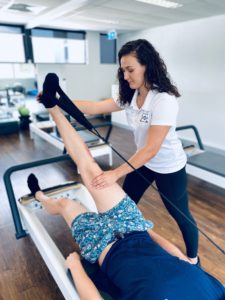What is Osteoporosis?
Osteoporosis is a disease which causes the bone to decrease in density, which over time results in the bone becoming brittle. Osteoporosis develops when bones decrease in minerals (such as calcium) faster than the body can replace them.
Over 1 million Australians have been diagnosed with Osteoporosis. People affected by this disease are at a higher risk of fractures and bone breaks than in normal bone. Osteoporosis is known as the ‘silent disease’ as it usually has no noticeable symptoms until a fracture or bone break occurs. (Osteoporosis Australia)
The Next Step:
When someone has a high risk of breaking a bone or is diagnosed with Osteoporosis they will normally be prescribed with medicine that will help strengthen their bones and prevent fractures. In conjunction with this, correct exercise prescription is also part of an effective plan as it increases and improves:
- Muscle strength
- Bone density
- Flexibility
- Posture
- Coordination
- Balance
By achieving these improvements it allows the body to support the weakened bones, assists with postural changes and helps prevent falls. This can be accomplished through various types of exercises including; weight bearing exercises, aerobic exercises, pilates and dancing. It is well known that Weight bearing exercises are needed in order to improve outcomes for those with Osteoporosis, but can Pilates also be effective?
Pilates for Osteoporosis – The Evidence:
A study was conducted following post menopausal women diagnosed with Osteoporosis for 1 year. The one group completed supervised Pilates exercises 2 times per week and the other group completed a home exercise program (not supervised). The results showed that the Pilates group had significantly more improvements on their pain, functional status, and quality of life, than the group that completed the home-based exercises.(Kucukcakir, Altan & Korkmaz 2012 in press)
Another study was conducted looking at more specific Pilates exercises. Four groups were split into flexion based exercises, extension, flexion and extension, and the last group had no exercises (the control group). The group with the extension focused exercises had the best result with only 16% of these participants having another fracture or bone break. All of the other groups had a greater risk of developing a fracture or bone break ranging from 53% to as high as 89%. (Sinaki & Mikkelson 2002).
One conclusion we can make from these study examples is that a proper supervised program conducted by a health professional such as a Physiotherapist or Exercise Physiologist that specialises in the field of Osteoporosis can help yield better outcomes.

Osteoporosis at Forge West End:
At Forge West End, our Physiotherapists and Exercise Physiologists are trained to make exercise adjustments for people diagnosed with Osteoporosis. Our Physiotherapist Vanessa has undertaken further training in providing Pilates specific programs for Osteoporosis. Once the patient is cleared by their GP, a thorough initial assessment would take place and an individualised exercise program would be designed based on the latest research and recommendations.
By Vanessa Cormack – Forge Physiotherapist
Comments are closed.

